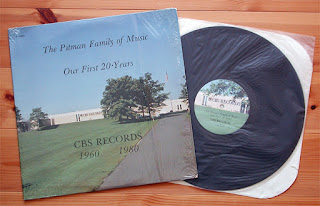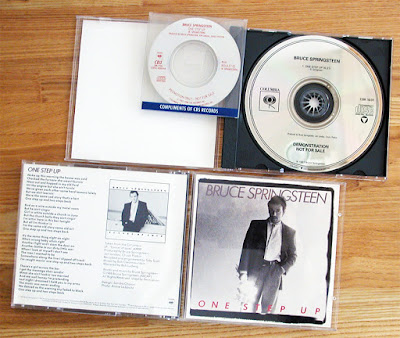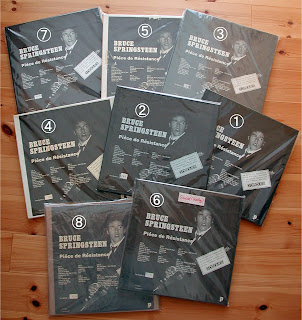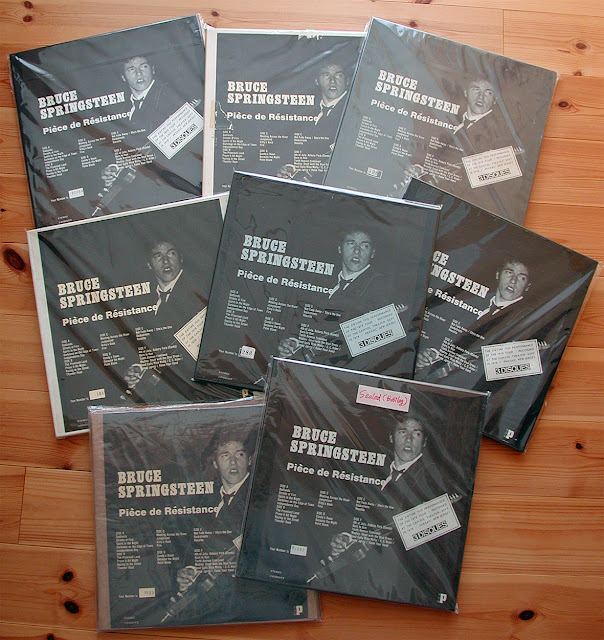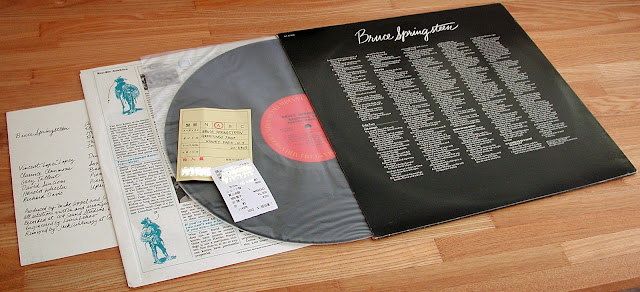 |
Two copies in my possession, one in excellent condition and the other in good condition.
Found on the insert sheets are the English lyrics for 10 tracks (left) and their Japanese translations (right). |
Definitely, one of the rarest and most sought-after LP releases from his entire official vinyl catalog. Given the estimated value of £1,400 or more for a mint copy, this promotion-only compilation album is ranked at the 5th position on the whole listing, and taking the 2nd place on the album listing (just next to the complete press-kit package of
BORN TO RUN or so called "
the Script cover" release), of the
Top 40 Worldwide Springsteen Rarities that appear as the feature article in the number 329 issue (November 2006) of
Record Collector magazine.
Unfortunately, there is no much information regarding this impossibly rare collectible from the Far East, with the release date back in 1978, nearly four decades ago. According to the magazine article mentioned above and the description from the
Lost In The Flood collector's web site, all the known facts can be summarized as follows:
 |
The catalog number and promo
indication on the rear sleeve |
- Released in Japan to promote the 4th album DARKNESS ON THE EDGE OF TOWN, despite not featuring any tracks thereof.
- Housed in a custom black & white picture sleeve without a decorative obi strip.
- Carrying white "Sample" labels on the wax.
- Including an insert with Japanese translations of the lyrics for the featured 10 tracks.
- Reportedly limited to just 100 copies.
- Marked his first exclusive compilation album all over the world.
For many years, I have not seen any copy offered, whether by private sale, set sale or auction. The following are additional notes and my trivial thoughts on this ultimate collectible:
On release date
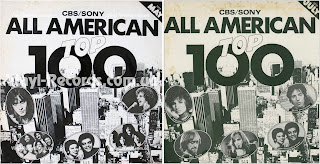 |
Two promo-only compilation LPs (YAPC 94 and 96) of ALL
AMERICAN TOP 100 released in May and July, 1978, respectively.
The July issue features Prove It All Night as the 6th track on
Side B (These are not in my possession). |
|
Some sources claims that this promo LP is released in advance of
DARKNESS (Release date: July 1st, 1978, which is almost one month behind the U.S. date) while the others say that they are issued simultaneously. The catalog number with a promo-only prefix (
CBS/SONY YAPC 95) suggests the release month to be June, because the two promo compilation issues (
YAPC 94 and
YAPC 96) immediately before and after this release are titled
ALL AMERICAN TOP100 May and
July, respectively (although this requires one assumption that these promo compilations were released monthly). So, this promo-only LP was probably issued in Japan slightly earlier than the
DARKNESS album, although the exact release date remains unknown.
 |
Record Labels print "A" and "B" although the
rear sleeve says "Side One" and "Side Two" |
On LP itself (sleeve, labels and matrix numbers, etc.)
On the rear sleeve are short introductions to all the individual tracks that are of course written in Japanese, which I don't think are worthwhile to translate into English. The record labels are typical white ones that had been used for sample and promo-only copies released from CBS/SONY until 1979, or at latest, early 1980. The matrix numbers are
YAPC-95A2 / YAPC-95B1 both of which are machine-stamped. There are no differences in the dead wax information between my two copies that carry the identical matrix codes. Found only on Side One is a
"JIS" mark logo that is also machine-typed on the run-off groove area (
JIS is a three letter acronym meaning "Japanese Industrial Standards", which is explained shortly in
the previous post).
The LP is often said to contain an insert with Japanese translations of the lyrics for the 10 tracks that are included in the album. But it actually prints the original English lyrics as well on the other side of the single paper sheet. It is reasonable that the LP was, as reported, in runs as limited as 100 copies, taking into the consideration the fact that there were only two FM stations (FM-NHK in common, and either FM-Tokyo or FM-Osaka) then in Tokyo and Osaka, the two largest cities in Japan, although there were much more AM radio stations. It is of note that unconfirmed number of the copies has been exported to the U.S. (see below).
Other notes that may interest you
 |
Both English lyrics and their Japanese translations are
printed using both sides of a single sheet. |
This promotion-only LP is briefly mentioned in the Japan-only booklet that accompanies the
THE PROMISE: THE DARKNESS ON THE EDGE OF TOWN Story box set (
SONY SIPC 2971-6). Among the featured articles in this 46-page black & white booklet is an interview with Mr. Ryo Okada (pages 8-10), who was back then responsible for promoting and marketing Springsteen at CBS/SONY Records (his career in charge of Springsteen continued at the company up to
NEBRASKA).
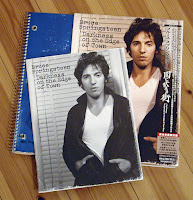 |
| Japan-only booklet of DARKNESS box |
In fact,
DARKNESS was hardly a hit album in Japan, sold only 30,000 to 40,000 copies domestically (Springsteen's first commercial success here had to wait until
THE RIVER). From this interview, I got to know a glimpse of how things went at marketing the album in Japan and what Mr. Okada thought and did to promote the sales of the album (which has substantially failed, though). At the first listening to the master tapes that arrived from the U.S., he was apparently baffled by the dark, low-key tone the album was to follow throughout, because he had expected that this long-awaited release would be something following up
BORN TO RUN, at least sound-wise. He confessed that he questioned the choice of the lead-off single release (i.e.,
Prove It All Night) which, he thought, was not strong enough to support the album sales as well as its own sales as 7-inch. He also confessed that it was quite tough with this single cut to compete against Stones'
Miss You which took the radio by storm at that time in Japan. Although
THE LAST AMERICAN HERO LP was obviously an outcome as part of promoting the
DARKNESS album primarily (and then Springsteen's back catalog as well), these circumstances could, at least in part, account for why this promo-only compilation album does not include any tracks from the 4th album (this part is just my guess).
 |
| The best official sleeve, in my opinion |
Interestingly, he recalled that
this first ever best hit-type compilation came into so repute in the U.S. (rather than in Japan, ironically) that he was requested to send there one box containing copies of this LP (in the interview, he neither mentioned how many copies nor specified to whom, but logically to someone at the U.S. Columbia Records), which he seems to be proud of. He also seems to consider that this Made-in-Japan special LP might have, at least in part, inspired them to produce the U.S. version of the compilation album, which resulted in the release of the promo-only
AS REQUEST AROUND THE WORLD LP (
US Columbia AS 978) in 1981. Overall, a very nice interview featuring rarely spoken tales from the inside of the industry, through which we can learn the company's situation being about to release
DARKNESS in Japan.
→
Check here for the related post.



